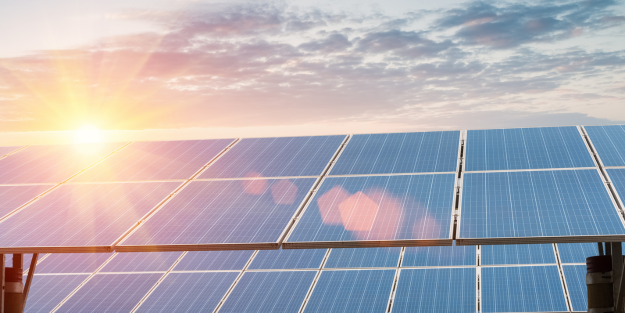Jump to question:
When and where was solar power invented?How many solar power jobs are there in the USA?
Where are the biggest opportunities for solar jobs in the USA?
What kind of jobs are there in solar power?
How much of the USA’s power comes from solar?
How many solar panels would be needed to power the USA?
Is solar power a cost-effective solution?
Is solar environmentally friendly?
Do solar power plants impact health?
How can I secure my next job in the US solar industry?
Solar power is one of the cheapest, cleanest ways of producing renewable energy. Its scalability, from generating power for individual homes to providing sustainable energy to entire communities through utility-scale developments, gives it a huge advantage over other power generation.
But there are a lot of misconceptions about solar power and its effectiveness or potential that still prevent significant uptake. Solar developers continue to struggle to find strong investment often in areas that it seems would obviously benefit from them.
As a specialist recruiter of engineering professionals for the renewable energy marketing, including many US solar businesses, we hear these stories all the time, both from our clients and from our engineering candidates. So we’re going to clear up some of the biggest myths by answering a few of the most frequently asked questions about solar energy.
When and where was solar power invented?
It may surprise you to learn that solar power is an American institution. It was invented in 1954 in Bell Labs, the research branch of the Bell Telephone Company in Murray Hill, New Jersey. Three engineers – Daryl Chapin, Calvin Fuller and Gerald Pearson – were working on a way to conduct electricity through thin strips of silicon. They discovered that electrons flowed freely through the silicon when it was exposed to light – and realised it could be used as a source of power.
As well as being invented in America, the States became a leading manufacturer, with up to 95% of the global solar market estimated to come from the USA in 1978.
However, things change, and these days up to 80% of solar panels used in the USA actually come from China. The introduction of the Inflation Reduction Act coinciding with Biden’s embargoes on Chinese imports means that there is a call and potential for some of that manufacturing to come back to the States.
How many solar power jobs are there in the USA?
According to the National Solar Jobs Census 2021, run by the US Department of Energy (DoE), the US solar industry employs 255,037 workers.
Of these: 168,960 are working in installation and project development, with demand for those growing (between 2020 and 2021, 14,350 additional jobs were added to the solar industry, a rise of 9.3%).
It’s a fast-growing market that calls for skilled engineering professionals to continue installing and developing new utility-scale solar projects across the USA.
Where are the biggest opportunities for solar jobs in the USA?
California is the leader in solar employment, with 75,712 jobs recorded in the National Solar Jobs Census 2021.
This is followed by Florida with 11,761 jobs, Massachusetts (10,548 jobs), New York (10,524 jobs) and Texas (10,346 jobs).
Solar jobs grew in 47 states in 2021, with the fastest growth coming from Alabama, which increased its solar jobs by 43%. Smaller markets like Nebraska, North Dakota, Idaho, West Virginia, Kentucky and Montana also saw rapid growth, with 18-24%.
What kind of jobs are there in solar power?
From system design to installation and operations, there are a lot of highly technical roles involved in large-scale solar projects.
Electrical engineers, photovoltaic engineers and solar installers account for a lot of the key roles involved in a project. But the essential connection between the engineering, procurement and construction sides comes from a solar project developer – someone who has experience and technical knowledge of the industry and past projects who can take responsibility for moving a project from pre-construction to completion.
Their work goes hand in hand with the solar project manager, who deals with the many tasks involved in pulling a project together, managing resources, costs, workers, timescales and hse. They are a bridge between the technical workers and the financial owners.
With technical experience in solar projects and insights into what it takes to achieve a development’s goals, a career as a solar industry specialist can prove extremely rewarding.
How much of the USA’s power comes from solar?
Despite the many obvious benefits of solar power, the US still hasn’t been as widely adopted across the States as you might think.
In 2022 it was estimated that solar power accounted for just 5% of the USA’s net energy generation, including both utility-scale and small-scale installations.
However, it is predicted that the significant investment in further utility-scale generation, in part aided by the passing of the IRA, will increase the growth of solar significantly, driving it to 20% of net power by 2050.
This promises a huge opportunity for anyone working within the industry or with any kind of large-scale project experience, as growth at this scale will create huge demand for skilled specialists.
How many solar panels would be needed to power the USA?
What if we could make solar power responsible for 100% of the USA’s energy needs? What would that look like? Massive, endless deserts of reflective panels covering areas the size of Texas? Entire Midwestern states surrendered to make room for lifeless blocks of silver, creating massive quantities of power for coastal cities? 90% of the country lost to provide energy to the remaining 10%?
Actually, according to Solar City, the required area could be much smaller than you think.
In fact, just 0.6% of the total surface area of the US would be needed – an area of around 17,500 square miles.
Ok, that’s not insignificant, but this is to power the entire United States with roughly 4 million gigawatt hours (GWh) of solar energy.
There’s interest from ambitious people with the resources to make it happen as well, with Elon Musk commenting on a proposal to a National Governors Association Meeting last year, saying:
“If you wanted to power the entire United States with solar panels, it would take a fairly small corner of Nevada or Texas or Utah.
“You only need about 100 miles by 100 miles of solar panels to power the entire United States…. The batteries you [would] need to store the energy, so you have 24/7 power, is 1 mile by 1 mile. One square mile.”
Ambitious? Certainly. Achievable? We’ll let you decide.
Is solar power a cost-effective solution?
Solar panels were estimated by the International Energy Agency in 2020 to be the cheapest source of electricity in history.
Because solar uses an infinite and free source of fuel, the only costs are in the installation and maintenance stages of a project. When that is a utility-scale project, using newer, more robust technologies and generating huge amounts of energy – the total cost of generation is very small. The IEA estimated that solar, in some regions, can now generate electricity “at or below” $20 per megawatt hour.
“For projects with low-cost financing that tap high-quality resources, solar PV is now the cheapest source of electricity in history.”
And that cost is falling. According to the financial advisory firm Lazard, the cost of producing 1 MWh of solar fell by 86% from 2009 to 2017. Factor in the impact of subsidies on new projects, and there is a huge benefit for solar investors.
Is solar environmentally friendly?
The obvious answer is yes, due to the lack of emissions produced during the process of generating power. Of course, the real answer gets more complicated when you look at the full lifecycle of a solar project.
The manufacture of solar panels requires metals including silver, copper, indium and tellurium – plus lithium is required for battery storage. That requires mining which has a significant environmental impact.
Generation requires a lot of water for the cooling process. Plus, utility-scale facilities can have a negative impact on wildlife and landscape. And finally, at the end of a photovoltaic panel’s life, it needs to be discarded, and there are still no large-scale, sustainable processes for recycling.
So development is not perfect, but then no form of power generation comes without some impact. You have to look at the full scope and weigh up if the positives outweigh the negatives. And when it comes to solar power, the level of clean energy generation with zero emissions more than makes up for the impact of manufacturing, with a solar panel estimated to pay back its own carbon footprint within six months to years.
Solar remains the best, cleanest energy producer, with an emissions footprint 13 times smaller than natural gas and 18 times smaller than coal.
And as more investment is put in, more research and development is put into creating panels that can be produced and installed in cleaner ways.
From January to June 2020, it was estimated that solar avoided by than 96 million metric tons of CO2 emissions that would have come from non-renewable sources.
Do solar power plants impact health?
There’s misinformation out there that solar farms can have adverse effects on human health, with rumours ranging from concerns of low-level electromagnetic fields to worries about rooftop panels conducting lightning.
The truth is that the impact of solar panels and large-scale solar farms on those living nearby has been studied extensively, and there has never been any scientific proof of any effects on the health of humans or animals.
In fact, the lack of air pollutants and carbon from power generated by solar farms means more clean air than the same level of power generated by other means.
How can I secure my next job in the US solar industry?
Amoria Bond’s specialist team of energy recruitment experts work with skilled candidates and leading developers of utility-scale solar projects across the United States.
To find out about our latest opportunities or learn how we can help you secure your next renewable energy job, get in touch with our teams today.





